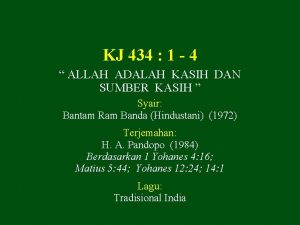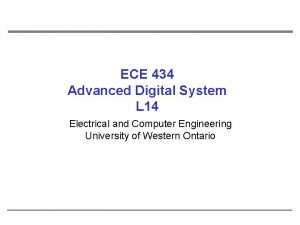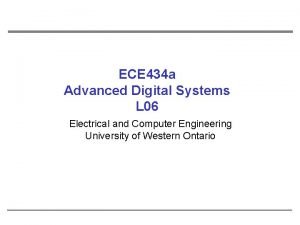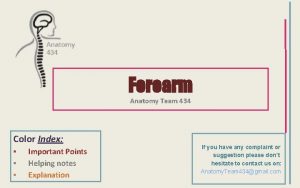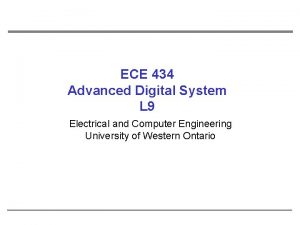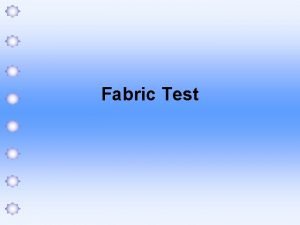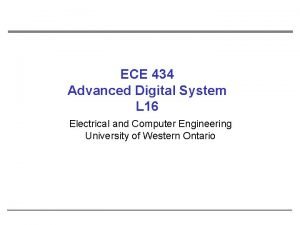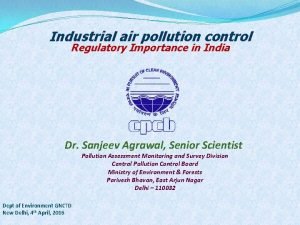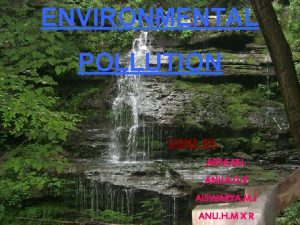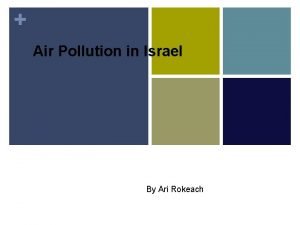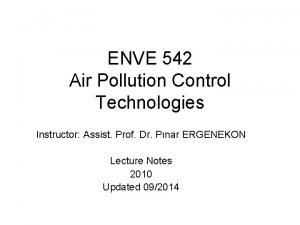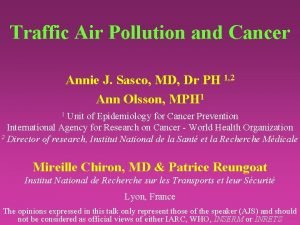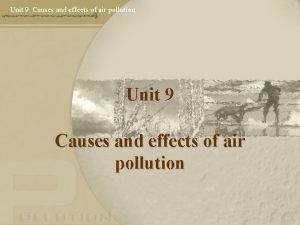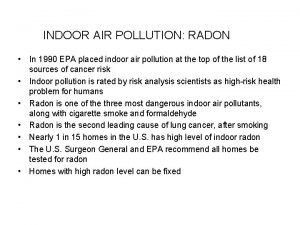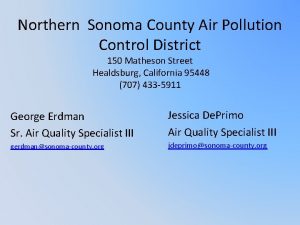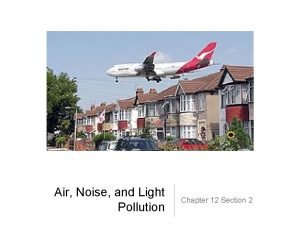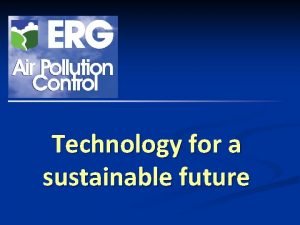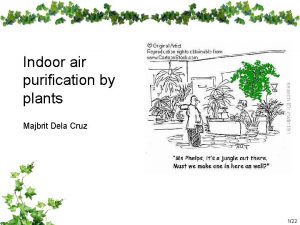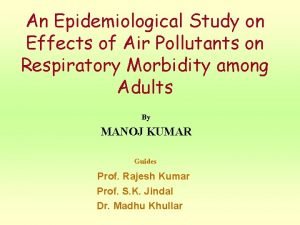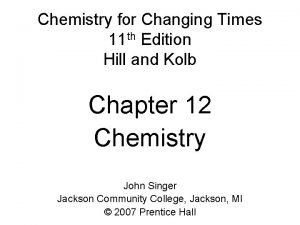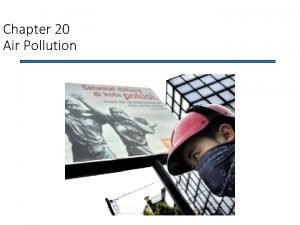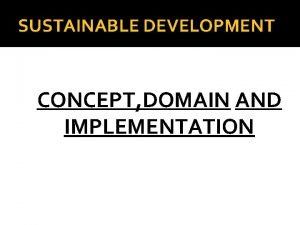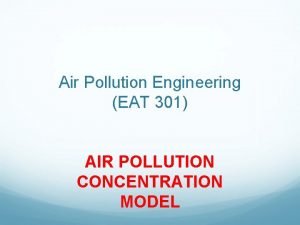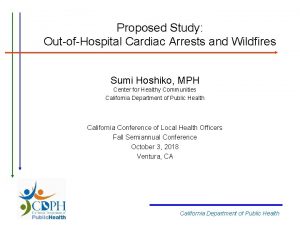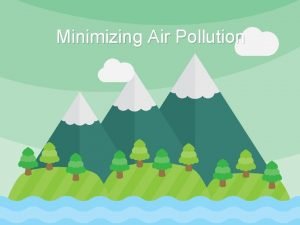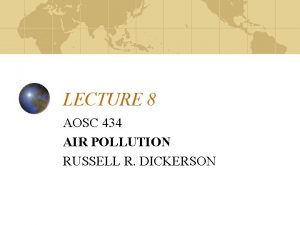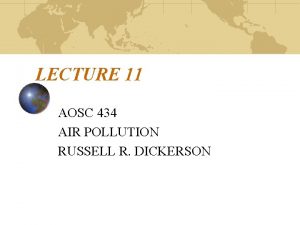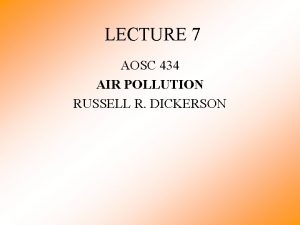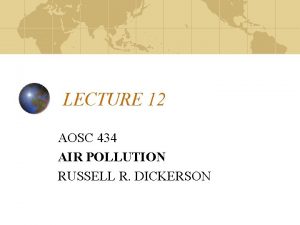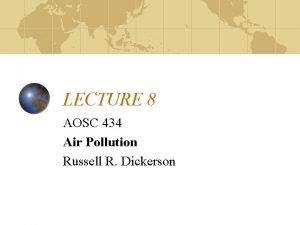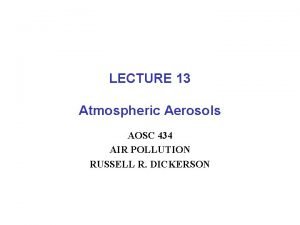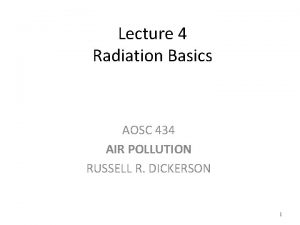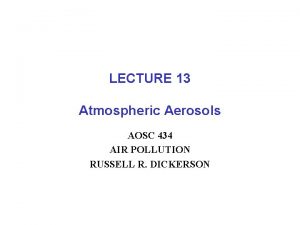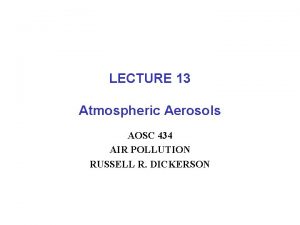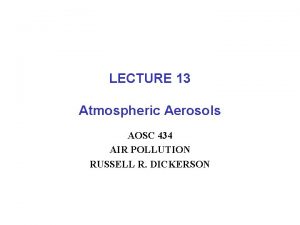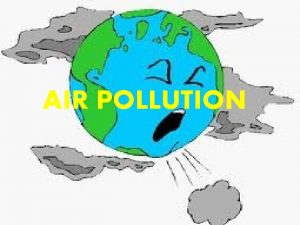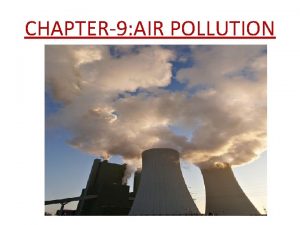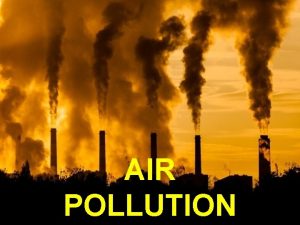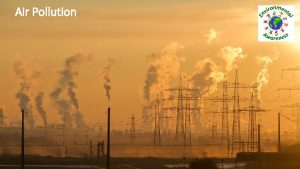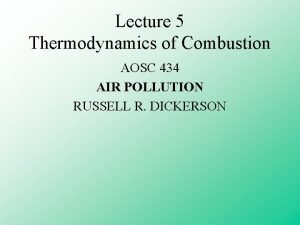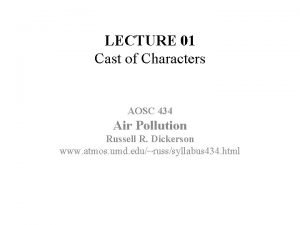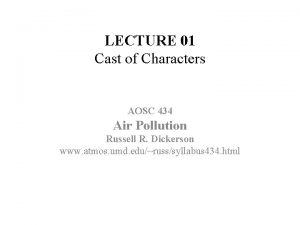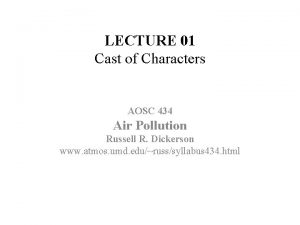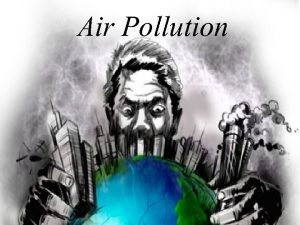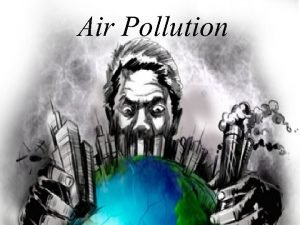LECTURE 10 AOSC 434 AIR POLLUTION RUSSELL R







































- Slides: 39

LECTURE 10 AOSC 434 AIR POLLUTION RUSSELL R. DICKERSON

IV. GASEOUS POLLUTION AND PHOTOCHEMICAL SMOG I. The Automobile Internal Combustion (Otto cycle) Seinfeld Chapt. 3 Wark and Warner Chapt. 10 Main cause of L. A. type smog Main source of CO, NMHC, and NOx (and Pb historically). Mobile sources much stronger source than stationary sources for all but NOx.

INTAKE - Downward motion draws in air/fuel mixture COMPRESSION - For higher efficiency POWER - Combustion initiated by spark plug EXHAUST - Push out burned hydrocarbons



Four-Stroke Engine

Four Strokes of an Engine

Two-Stroke Engine



Exhaust is not the only source of air pollutants. In an unregulated auto: Hydrocarbon Sources in an Unregulated Auto Gas tank 10% Carburetor 10% Crankcase* 25% Exhaust 55% Total * Called "Blowby" 100%

Evaporation from gas tank and carburetor are easy to control, but essentially all of the NOx, CO, and Pb comes from the exhaust. Recirculation System • Positive crankcase ventilation • Recirculating exhaust gas w/ O 2 sensor feedback. • Without controls 3% of the fuel would be lost

II. How to Tune a Car Equilibrium calculation told us to burn lean and at high compression to produce less CO. High compression also ups thermodynamic efficiency; Carnot cycle efficiency is defined as follows where TC is the temperature of combustion exhaust and TH is the temp as the heat enters the system: Eff. ≤ 1 – TC/TH A. Air-Fuel-Ratio Best power at AFR of 12. 5 (rich) Best mileage at 15. 5 (lean) ARF above 17 causes misfiring ARF below 10 causes flooding and plug fouling ARF of about 14. 5 ( = 1. 0) is stoichiometric

Indy 500 Helio Castroneves, winner in 2001, 2002 and 2009 As of 2015, all entrants use 2. 2 L V 6, twin-turbocharged engines, tuned to produce 550– 700 HP (410– 520 k. W). 2016 Honda Civic has 160 -170 HP. Why do they burn ethanol?

• Automobiles: Otto cycle the cycle used in spark-ignition internal combustion engines run on gasoline. Its theoretical efficiency depends on the compression ratio r of the engine and the specific heat ratio (Cp/Cv = γ) of the gas in the combustion chamber. The higher the compression ratio, the higher the temperature in the cylinder as the fuel burns and so the higher the efficiency. The maximum compression ratio usable is limited by the need to prevent preignition (knocking), where the fuel ignites by compression before the spark plug fires. The specific heat ratio of the air-fuel mixture γ ~1. 40. Compression ratios for gasoline powered cars range from 10: 1 to 14: 1 for racing engines. Alcohol powered cars have 15: 1; Diesel 14: 1 to 23: 1.

B. Compression Higher compression means higher power • Problem - Detonation occurs when the fuel beyond the flame front initiated by the sparkplug burns. This is also called autoignition or knocking. • Octane rating proportional to the detonation temperature. • Higher octane allows higher compression. • An enormous search found lead, in the form of tetraethyl lead, Pb(C 2 H 5)4, inhibits detonation. More on this later.

C. Timing Definition of Crank angle, advance vs. retard. • Combustion takes time, about 5 ms. • Combustion should occur at Top Dead Center (TDC), therefore spark must precede piston. • The higher the engine speed (RPM's) the more advanced the spark must be. Vacuum or centrifugal advance now replaced by electronic ignition. • As lower octane fuel is used, the spark must be retarded. Effectively reduces compression thus reducing power and fuel economy. • Retarding the spark reduces the maximum and end temperatures of combustion and thus reduces both CO and NO formation.

D. Fuel An octane rating of 100 means the same antiknock properties as isooctane (2, 3, 4 trimethyl-pentane). Without lead in the fuel more aromatic and branched HC must be mixed into the fuel. But these species are more reactive with respect to photochemical O 3 formation. Modern cars have a Knock Detector and adjust the ignition timing to account for low octane fuel.

Fuel Octane value n-heptane 0 1 -heptene 60 Iso-octane 100 Ethanol 109 Aviation rich 130

Lead is an insidious, cumulative poison. High serum (blood) lead has been linked to neurological and reproductive effects including reduced intellect. Poisoning is hard to diagnose because symptoms include anemia, constipation, and abdominal pain, in short the malaise of modern humans. More than 5 g Pb /dl blood leads to adverse health effects. In California cities in 1974 the atmospheric lead concentration was about 1. 5 g/m 3. The clean air background is about 0. 01 g/m 3. Essentially all the lead in the air was from automobiles. By 1987 most American cities had a lead content below 1 g/m 3; the ambient air quality standard is 0. 15 g/m 3 for an annual average and all cities attain this. Today only re-suspended lead (from soil) is an issue.

Lowest Exposure Dose Signs and Symptoms: Impaired Cognitive Abilities/Subclinical Neuro/Psychoneuro/Neurobehavioral Findings (patient may appear asymptomatic) • Decreased learning and memory • Decreased verbal ability • Early signs of hyperactivity or ADHD • Impaired speech and hearing functions • Lowered IQ coma, and death • Paresis or paralysis https: //www. atsdr. cdc. gov/csem. asp? csem=34&po=8

Why you should be smarter than your parents.

Modern threeway catalytic converter

Actual units

Diesel Engines There are no sparkplugs in a diesel engine. The fuel is injected at the time of maximum compression (near TDC) and the heat of compression causes combustion. Diesel Engines have no throttle on the air. Detonation impossible. Low octane, "cheap, " fuel may be used. Compression must be higher (~18: 1 vs. 9: 1 for Otto cycle). Improved efficiency, but bigger and heavier engine block required. Fuel mix is leaner, i. e. < 1. 0. Low CO and HC, but high NOx. Lots of particles including soot and PAH.

III. Exhaust Emissions a) Hydrocarbons Some fuel remains unburned even after combustion; why? The Temp at the time of combustion is 2500 - 3000 o. C, but walls of the cylinder are around 200 o. C. Exhaust starts ~1000 o. C, but cools quickly. Poor mixing and absorption of HC into oil on walls creates a quench zone. HC are concentrated in the first and last components of the exhaust. The NO profile is opposite. To control HC emissions from the quench zone, the surface to volume ratio should be kept to a minimum, but that reduces stroke and compression.

b) Carbon Monoxide CO 2 CO + 1/2 O 2 Keq = e(- G/RT) The process becomes kinetically limited as expansion occurs. The formation of CO is quick, but the removal is slower, especially at temperatures below about 1000 K. Thus the [CO] is close to the [CO] calculated by the above equilibrium method based on the temperature of the exhaust gases at the end of expansion.




Diesel Engine

Model Diesel Engine

Major advantages, cont. * Diesel fuel (longer HC chains) is safer than gasoline. Diesel fuel will burn in open air using a wick; it will not explode. The low vapor pressure of diesel is especially advantageous in marine applications. For the same reason, diesel engines are immune to vapor lock. * For any given partial load the fuel efficiency (mass burned per energy produced) of a diesel engine remains nearly constant, as opposed to gasoline and turbine engines which use proportionally more fuel with partial power outputs. * They generate less waste heat in cooling and exhaust. * Diesel engines can accept super- or turbo-charging pressure without any natural limit, constrained only by the strength of engine components. This is unlike gasoline engines, which inevitably suffer detonation at higher pressure. * The carbon monoxide content of the exhaust is minimal. * Biodiesel is an easily synthesized, non-petroleum-based fuel (through transesterification) which can run directly in many diesel engines, while gasoline engines either need adaptation to run synthetic fuels or else use them as an additive to gasoline e. g. , ethanol added.

Diesel engines, Major disadvantages: • Diesel engines are larger, heavier and more expensive than spark ignited engines. • Tolerances on valves and rings stricter due to higher compression. • Noise • Greater NOx and soot generation.

The equivalence ratio (ratio of fuel to air relative to stoichiometric) and temperature establish the emissions of internal combustion engine. Local ER is high near injectors. Low Temp Combust (LTC) can minimize both.

Take Home Messages for Internal Combustion Engines. 1. Generate most of the CO and NOx in N. America. 2. Four stroke spark ignited engines generate a lot of CO and substantial NOx. 3. Two-stroke spark ignited engines generate aerosols, CO, VOC’s, but little NOx. 4. Diesel engines run hot and lean and generate NOx and soot, but little CO. 5. Modern catalytic converters are ≥ 90% effective for CO, VOCs, and NOx.



 Chapter 12 section 3 acid precipitation
Chapter 12 section 3 acid precipitation Chapter 12 air section 1 what causes air pollution
Chapter 12 air section 1 what causes air pollution Pt tanah air sentosa
Pt tanah air sentosa 434 x 2
434 x 2 Allah adalah kasih dan sumber kasih
Allah adalah kasih dan sumber kasih Ece 434
Ece 434 Ece 434
Ece 434 Anatomy team 434
Anatomy team 434 Ece 434
Ece 434 Astm d 2261
Astm d 2261 Ece 434
Ece 434 Anatomy team 434
Anatomy team 434 01:640:244 lecture notes - lecture 15: plat, idah, farad
01:640:244 lecture notes - lecture 15: plat, idah, farad Pollution control laws in india
Pollution control laws in india Objective of environmental pollution
Objective of environmental pollution Ari rokeach
Ari rokeach Air pollution control technology
Air pollution control technology Land water and air pollution
Land water and air pollution Conclusion of air pollution
Conclusion of air pollution What is pollution how is it caused
What is pollution how is it caused Radon indoor air pollution
Radon indoor air pollution Control measures of noise pollution
Control measures of noise pollution Northern sonoma county air pollution control district
Northern sonoma county air pollution control district Section 2 air noise and light pollution
Section 2 air noise and light pollution Erg air pollution control
Erg air pollution control Conclusion for air pollution presentation
Conclusion for air pollution presentation Indoor air pollution sources
Indoor air pollution sources Aim or objectives of air pollution
Aim or objectives of air pollution Air pollution wildfires
Air pollution wildfires Acid rain in canada
Acid rain in canada Two sources of air pollution
Two sources of air pollution Air pollution definition
Air pollution definition Air pollution box model example
Air pollution box model example Introduction of pollution
Introduction of pollution Air pollution specialist
Air pollution specialist Air pollution wildfires
Air pollution wildfires Air pollution
Air pollution Indoor air pollution examples
Indoor air pollution examples Air pollution
Air pollution Air pollution
Air pollution




